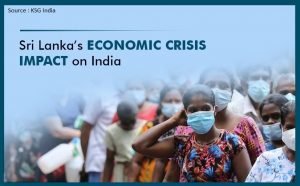Reasons behind Sri Lankan Economic Crisis
Sri Lanka is currently in an economic and political crisis of mass proportions, recently culminating in default on its debt payments. The country is also nearly empty on its foreign currency reserves, decreasing the ability to purchase imports and driving up domestic prices for goods.
There are several reasons for this crisis and the economic turmoil has sparked mass protests and violence across the country.
This country doesn’t have enough fuel for essential services like buses, trains, and medical vehicles, and officials say it doesn’t have enough foreign currency to import more. This lack of fuel has caused petrol and diesel prices to rise dramatically. In late June, the government banned the sale of petrol and diesel for non-essential vehicles for two weeks. Sales of fuel remain severely restricted. Schools have closed, and people have been asked to work from home to help conserve supplies.
The Key Information
“Our economy has completely collapsed.”
PRIME MINISTER RANIL WICKREMESINGHE TO PARLIAMENT 20th JULY 2022.
One of the main causes of the economic crisis in Sri Lanka is the reliance on imports and the amount spent on them. Let’s take a look at the numbers:
- 2021 total imports = $20.6 billion USD
- 2022 total imports (to March) = $5.7 billion USD
In contrast, the most recent reported foreign currency reserve levels in the country were at an abysmal $50 million, having plummeted an astounding 99%, from $7.6 billion in 2019.

Some of the top imports in 2021, according to the country’s central bank were:
- Refined petroleum = $2.8 billion
- Textiles = $3.1 billion
- Chemical products = $1.1 billion
- Food & beverage = $1.7 billion
Of course, without the cash to purchase these goods from abroad, Sri Lankans face an increasingly drastic situation.
Additionally, the debt Sri Lanka has incurred is huge, further hampering its ability to boost its reserves. Recently, they defaulted on a $78 million loan from international creditors, and in total, they’ve borrowed $50.7 billion.
The largest source of their debt is by far due to market borrowings, followed closely by loans taken from the Asian Development Bank, China, and Japan, among others.
What it Means
Sri Lanka is home to more than 22 million people who are rapidly losing the ability to purchase everyday goods. Consumer inflation reached 39% at the end of May.

Due to power outages meant to save energy and fuel, schools are currently shuttered and children have nowhere to go during the day. Protesters calling for the president’s resignation have been camped in the capital for months, facing tear gas from police and backlash from president Rajapaksa’s supporters, but many have also responded violently to pushback.
India and China have agreed to send help to the country and the International Monetary Fund recently arrived in the country to discuss a bailout. Additionally, the government has sent ministers to Russia to discuss a deal for discounted oil imports.
What were the factors that triggered the Sri Lankan Economic Crisis
Some of the factors that triggered the economic crisis in Sri Lanka were:

- The Covid-19 Pandemic put the tourism industry on hold. It accounted for 10% of Sri Lanka’s GDP
- This led to a dip in the forex reserve (from $7.5 billion in 2019 to $2.8 billion in July 2021).
- A dip in other sources of revenue led to high costs in importing essential items, including food.
- A depreciated currency, high dependence on imports, and hoarding led to a steep rise in food prices in Sri Lanka.
- The Hambantota port was another white elephant project by the present government to shorten its economic woes. Instead, it only further increased the debt problem that Sri Lanka faced as it had taken $1 billion from China.
- The ongoing Russo-Ukrainian Conflict also is a factor that is affecting the already precarious economic condition of Sri Lanka.
- The reason is that Sri Lankan tourism relies on arrivals from Russia and Ukraine
- Russia is also the second biggest market to Sri Lanka when it comes to tea exports.
- Thus, the war in Ukraine put a serious dent in the path to the economic recovery of Sri Lanka.
2022 Sri Lankan political crisis
The 2022 Sri Lankan political crisis is an ongoing political crisis in Sri Lanka due to the power struggle between President Gotabaya Rajapaksa and the Parliament of Sri Lanka. It is fueled by the anti-government protests and demonstrations by the public due to the economic crisis in the country. The anti-government sentiment across various parts of Sri Lanka has triggered a state of political instability the country has not seen since the countries history.
The political crisis began on 3 April 2022, after all 26 members of the Second Gotabaya Rajapaksa cabinet with the exception of Prime Minister Rajapaksa resigned en masse overnight. Critics said the resignation was not valid as they did not follow the constitutional protocol and thus deemed it a “sham”, and several were reinstated in different ministries the next day. There were even growing calls on forming a caretaker government to run the country or for snap elections, but the latter option was deemed unviable due to paper shortages and concerns over election expenditure, which would often cost in billions.
How is the Crisis in Sri Lanka Impacting India?
Challenges:
- Economic: Sri Lanka’s share in India’s total exports has declined from 2.16% in FY15 to just 1.3 percent in FY22. Automotive firms like Tata Motors and TVS Motors have stopped exports of vehicle kits to Sri Lanka and halted production at their Sri Lankan assembly units due to its unstable forex reserves and fuel shortages.
- Refugee: Whenever a political or social crisis has occurred in Sri Lanka, India has witnessed a large influx of ethnic Tamil community refugees from the Sinhala Land to India through the Palk strait and Gulf of Munnar. However, India may find it difficult to handle such an influx and needs a robust policy in place to handle the crisis. The state of Tamil Nadu has already started feeling the impact of the crisis with the reported arrival of 16 persons from Sri Lanka through illegal means.
- Organic Farming: The government failed to increase domestic production of organic pesticides and fertilizers, or provide farmers with subsidies to buy these. The sudden policy shift wrecked crop yields. Rice, Sri Lanka’s dietary staple that it used to produce adequately and even exported, saw average yields slashed by some 30%. For the first time in decades, Sri Lanka had to import rice. The production of tea, the country’s prime export, fell by 18%, crimping its foreign exchange earnings. Bending to protests by farmers, the agrochemical import ban was eased in November. But there was still no going back to subsidizing chemical fertilizers like before.

Opportunities:
- Tea Market: Amid the sudden halt of tea supply by Sri Lanka to the global tea market, India is keen to plug the supply gaps. India could strengthen its footprint in Iran as well as new markets such as Turkey, and Iraq. Big Sri Lankan tea importers from Iran, Turkey, Iraq, and Russia are reportedly visiting India for tea plantations in Assam and Kolkata. As a result, at recent Kolkata auctions, the average price for orthodox leaf saw an increase of up to 41% compared to corresponding sales last year.
- Apparel (Clothing) Market: Many apparel orders from the United Kingdom, European Union, and Latin American countries are now being diverted to India. Several orders have been given to companies in Tirupur, the hub of the textile industry in Tamilnadu.
How can Sri Lanka overcome the Crisis?

Implementing Democracy in True Spirit: There is a need for strong political consensus in Sri Lanka for better crisis management. Militarisation of Administration can be reduced.
Considerations are needed to help the poor and vulnerable get back on their feet and prevent long-term scarring.
The steps include an increase in agricultural productivity, increased job opportunities in non-farming sectors, better implementation of reforms, and reviving the tourism sector.
Sri Lanka has to improve its forex earning capacity in order to achieve debt sustainability as well as to move beyond and above recovery. Fiscal consolidation is needed as a medium-term measure, but the reforms should be extended to eliminate the country’s anti-export and anti-FDI biases. A crisis is an unprecedented opportunity to carry out the necessary reforms – one that should not be missed.


